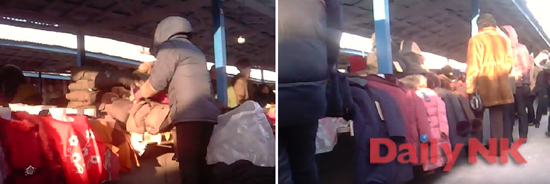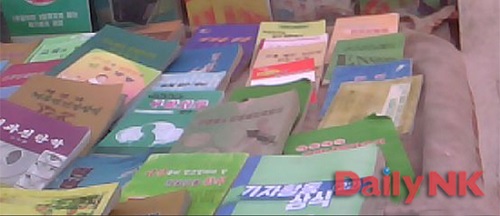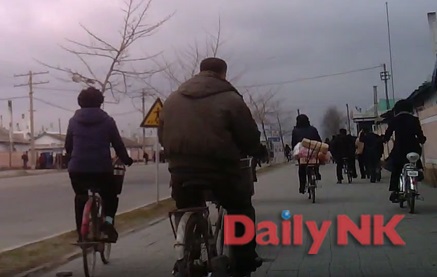Above: An exclusive video from Unification Media Group shows markets in North Korea’s North Hamgyong Province. Please do not use or reproduce the video without permission. It is also available on Youtube.
A product called “Star Pie” has debuted in Pohang Market in North Hamgyong Province’s Chongjin City. The chocolate snack is an imitation of a popular South Korean product called “Choco Pie.” Looking at the video shot in Chongjin in early March, a box of “Star Pies” with English writing can be clearly seen on display. The product is presumed to be of Chinese origin. It is highly unusual to see a product for sale in North Korea’s markets with blatantly visible English writing.

In addition to the Star Pies, another box frequently seen in the markets has the English language label “SOFIA Premium.” Daily NK’s sources note that the markets have become an essential feature of the resident’s lives, and it’s more common to encounter people with the attitude that, “anything needed can be provided, no matter how much the authorities try to crack down on it.”
North Hamgyong Province’s Chongjin City plays host to some of the country’s largest markets, including Pohang and Sunam Market. According to a report released last year by the Korea Institute for National Unification (KINU), Sunam Market covers some 23,487 square meters, while Pohang Market occupies 12,074 square meters. The supply of goods is proportional to the area of the markets. A large range of goods are offered for sale, including foodstuffs, home goods, and appliances, etc.

The quality of the products appears reasonable. A stall selling household goods in Pohang Market is lined with quality rice cookers, cabinets, full-length mirrors, and thermoses. There are also products that appear to be either air purifiers or dehumidifiers. Upon viewing the video, a defector from Chongjin who left North Korea in 2012 said, “Chongjin has had the biggest markets with the widest selection for some time. But I was surprised to see that it developed to such an extent that top shelf appliances are openly for sale.”

Many people are selling winter clothes in the market’s stalls. Thick jumpers and winter coats of every color can be seen lining the racks. Female shoppers tend to prefer mink coats or jumpers with fur around the collar. The defector from Chongjin added, “Because Chongjin’s markets have developed, the people’s lives have improved.”

There is also a used book stall near the entrance of Sunam Market with a diverse selection of specialty publications. For sale are baby books, books about internal medicine, and books about journalistic reporting.

Storefronts outside the market’s entrance have fashionable clothing on display. Unlike the market stalls, the clothes are put on mannequins or displayed behind glass. At stands selling food items, large refrigerators with Chinese writing on them draw the eye. The sale of Chinese products remains officially restricted, and seeing Chinese writing on a refrigerator is therefore still an unusual occurrence.
Another defector with experience selling in the marketplace added, “Even just a few years ago, we had to cover up products that had any writing in foreign languages. It’s surprising to see goods for sale with English and Chinese writing just right out in the open. This is likely an indicator that the distribution of imported goods has become routine.”
One source with ties to North Korea noted, “Recently, people have started to regard products with foreign writing on them as more expensive. The merchants could easily cover up the writing or erase it, but they are leaving it on display to attract the attention of passersby.”

As the marketplace continues to develop, more and more Chongjin residents are getting involved. In the video, we can see people transporting goods on their way to the marketplace. Some carry large bundles on their head. The markets have become a symbol of the people’s livelihoods.
The markets are a double edged sword for Kim Jong Un. On the one hand, they provide the regime with a necessary source of revenue. Merchants aspiring to sell in the General Markets like Sunam or Pohang are required to submit daily payments (500-1,500 KPW) to the market management offices. By tacitly permitting the country to marketize, Kim Jong Un has found a new and reliable source of money.
On the other hand, the marketplace also brings ideological changes to the North Korean population that may threaten the regime. In the past, socialist countries have been unable to avoid regime change in large part due to the changes caused by marketization. The same applies to North Korea. The people have become acquainted with the value of money and are now hesitant to rely on the leader or the party. We can only wait and see how long Kim Jong Un and the country’s markets are able to coexist.
Sunam Market is the biggest wholesale market in North Korea. Large quantities of products are imported from abroad and the country’s other regions before being sold at Sunam. The goods are then redistributed to various locations around the country to be sold directly to consumers. According to a KINU report, Sunam Market had 16,776 stalls last year and handles large quantities of craft goods and fisheries products. While other markets still require vendors to carry physical verification slips indicating that they have paid their stall fees, vendors at Sunam Market receive cards that they can slide through electronic terminal machines upon entry into the market.
Pohang Market is located on the east side of North Hamgyong Province and is smaller than Sunam Market. Upscale products can be purchased in Pohang. Some residents call it the “Donju’s Market.” (DonjuLiterally "masters of money," donju refers to people who hav... More means “money master” and is a term used in North Korea to describe the country’s newly-affluent middle class).

















